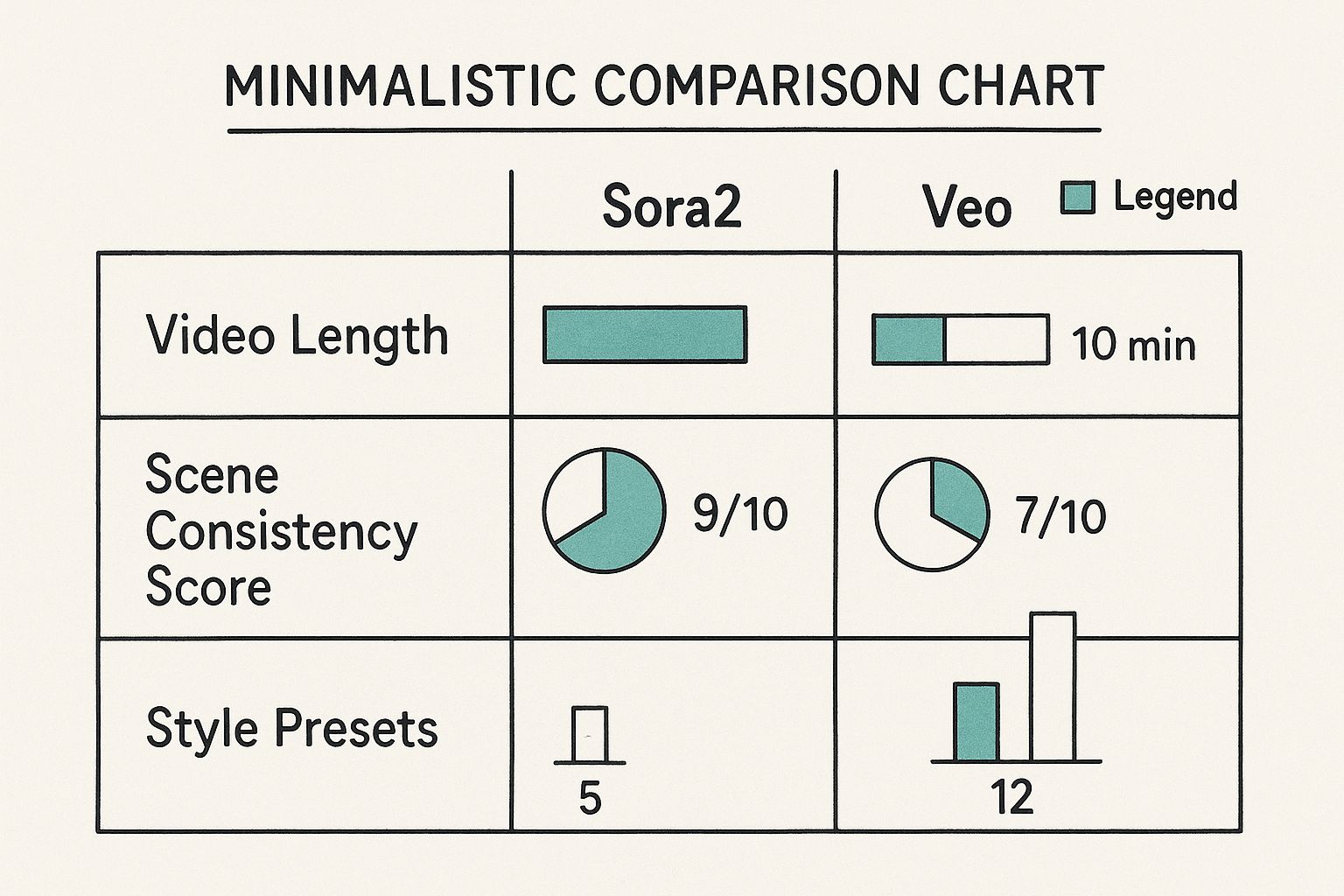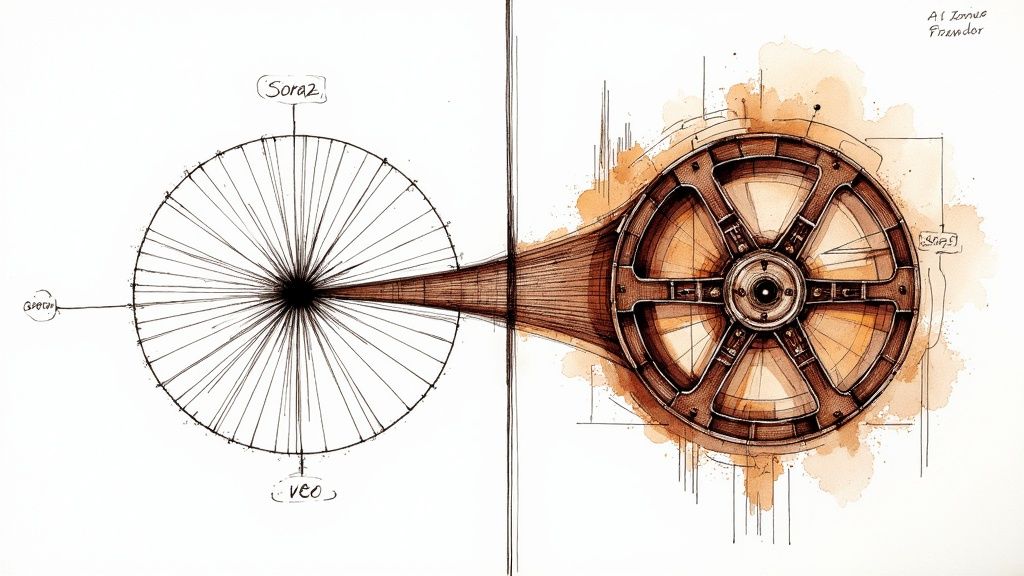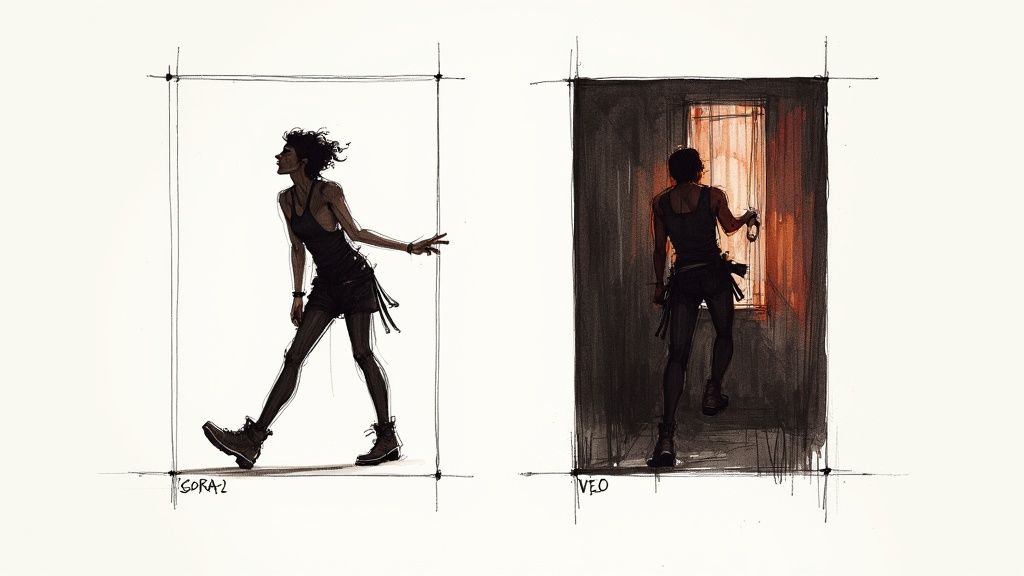- Блог
- Sora2 vs Veo: сравнение инструментов ИИ‑видео
Sora2 vs Veo: сравнение инструментов ИИ‑видео
Генерация видео из текста на базе ИИ — это уже не далекая перспектива. Она здесь, и это практичный инструмент, который уже меняет работу креативных специалистов. Два имени впереди: Sora2 и Veo. Хотя оба впечатляют, Sora2 быстро заработала репутацию благодаря умению генерировать более длинные и связные видеопоследовательности.
Выбор правильной платформы — это больше, чем просто выбор инструмента; это решение, которое сформирует качество и эффективность ваших проектов с самого начала.
Разбираемся в новой эпохе ИИ‑видео
Это руководство призвано отсеять шум и дать вам честное сравнение лицом к лицу. Будь вы создателем, маркетологом или кинематографистом, мы пойдём дальше броских характеристик и разберём то, что действительно важно: качество видео, творческий контроль, практическая применимость и то, как эти модели ведут себя в реальных задачах.
Чтобы лучше понять новую волну ИИ‑видео, полезно освоить фундаментальные принципы создания ИИ‑видео. Эта база поможет по‑другому взглянуть на продвинутые возможности, которые предлагают Sora2 и Veo.
Давайте быстро посмотрим, как они соотносятся. Эта диаграмма показывает ключевые метрики производительности — от длины ролика до согласованности сцен.

Сразу видно явное преимущество Sora2 по длительности видео и способности поддерживать согласованность между сценами. Это делает модель естественным выбором для проектов с повествованием, тогда как сильная сторона Veo — более широкий стилистический диапазон.
Ключевые различия одним взглядом
Правильный инструмент может сделать проект — поэтому разложим базовые отличия максимально просто. Считайте это быстрым справочником перед углублённым разбором.
| Feature | Sora2 | Veo |
|---|---|---|
| Primary Strength | Отличается долгими повествовательными роликами и согласованностью сцен. | Заточен под стилистическое разнообразие и быстрые итерации. |
| Target Audience | Выбор для режиссёров, аниматоров и рассказчиков историй. | Идеален для маркетологов, SMM‑менеджеров и визуальных художников. |
| Creative Focus | Главная цель — поддерживать реализм на протяжении длинных шотов. | Фокус на достижении конкретных кинематографичных стилей и эффектов. |
| Video Length | Способна генерировать заметно более длинные непрерывные видео. | Оптимизирована для коротких, эффектных клипов. |
Эта таблица отлично подводит к подробному взгляду на технологии и реальные результаты, которых можно ожидать от каждой платформы.
Сравнение базовых технологий и возможностей

Чтобы по‑настоящему понять Sora2 и Veo, нужно посмотреть под капот. Их базовые технологии принципиально различаются — и это определяет всё: от типа генерируемых видео до оптимальных сценариев применения.
Sora2 построена на архитектуре диффузионного трансформера. Проще говоря, модель изначально спроектирована для создания длинных видео, которые логично связаны от начала до конца. Её главная сила — согласованность: персонажи сохраняют внешность, а объекты — положение при смене сцен.
Veo, напротив, использует генеративный подход с упором на стиль и гиперреалистичные текстуры. Это даёт преимущество, когда нужен конкретный кинематографичный вид. Вроде «драматические аэро‑шоты» или «плавные таймлапсы» — Veo справляется с ними с минимальными подсказками.
Как технологии превращаются в функции
Что значит вся эта техника для вас, создателя? Многое. Архитектура Sora2 делает её инструментом для любых задач с повествованием. Она умеет связывать кадры в цельную историю, где важны переходы и логика сцен, а не отдельный идеальный кадр.
Модель Veo заточена под эстетический удар в коротких клипах. Её возможности ориентированы на быстрое получение впечатляющих визуалов. Упор на мгновенный эффект — это идеально для соцсетей, рекламы или самостоятельных визуальных работ. Это ключевое отличие должно направлять ваш выбор.
Базовое различие — в цели. Sora2 стремится симулировать последовательный, правдоподобный мир во времени, тогда как Veo фокусируется на выдаче конкретной визуальной эстетики с высокой точностью в коротком формате.
Такое технологическое расхождение рождает разные творческие ощущения. Одна — инструмент рассказчика, другая — холст визуального художника. Чтобы увидеть место Sora2 и Veo в индустрии, полезно взглянуть на обзор 12 лучших инструментов ИИ‑видео для создателей в 2025.
Sora2 vs Veo: сравнение возможностей
Чтобы упростить выбор, разложим ключевые отличия в прямом сопоставлении. Эта таблица даёт верхнеуровневое понимание сильных сторон каждой платформы.
| Feature | Sora2 | Veo |
|---|---|---|
| Core Architecture | Диффузионный трансформер | Латентная диффузионная модель (оптимизирована под стиль) |
| Ideal Video Length | 60+ секунд, отлично для длинных повествовательных последовательностей. | Короткие клипы (10–30 секунд), оптимизированы для визуального удара. |
| Primary Strength | Повествовательная согласованность и логичная прогрессия сцен. | Кинематографичный контроль и стилистическая гибкость. |
| Prompt Understanding | Глубоко интерпретирует сложные сюжетные промпты и действия персонажей. | Отлично понимает визуальные и стилистические команды. |
| Visual Fidelity | Сильный реализм с упором на целостность мира. | Гиперреалистичные текстуры и специализированные эффекты. |
| Best Use Cases | Короткометражки, сторибординг, многосценовые истории. | Маркетинговые клипы, соцсети, арт‑шорты, визуальные эффекты. |
| Learning Curve | Более крутая для освоения нарратива. | Интуитивна для быстрого достижения нужного стиля. |
Речь не о том, кто «лучше» в целом, а о том, что лучше под задачу. Вы строите мир или рисуете момент?
Замечание о названиях и восприятии рынка
Любопытно, как названия и брендинг отзываются в несвязанных сферах. Пока видеомодель Sora2 набирает обороты, в другом мире — волатильных криптовалют — существует однокоренное название, Sora (XOR). Это пример того, как сильный бренд может всплывать в неожиданных местах.
В итоге ваш выбор между этими платформами сводится к простому вопросу: вы рассказываете историю или ловите момент? Ответ покажет, к какому инструменту тянуться.
Качество видео и кинематографичность

Все разговоры о технологиях ничего не значат, если финальный ролик не «держит». Поэтому перейдём от спецификаций к результатам Sora2 и Veo. Настоящий тест text‑to‑video — насколько убедительно инструмент превращает простой текстовый запрос в то, что хочется смотреть.
С точки зрения фотореализма обе платформы впечатляют, но преследуют разные цели. Sora2 одержима симуляцией реального мира: отлично передаёт свет и тени, создает осязаемые текстуры и сохраняет целостность сцены. Такой физический реализм делает ролики похожими на съёмку реальной камерой.
Veo, напротив, чаще выдаёт сразу эффектные и стилизованные визуалы. Детали и цвета бывают по‑киношному сочными, иногда ценой идеальной физики. Это не слабость, а другой подход — приоритет эстетического удара над строгой симуляцией.
Как они справляются с движением и персонажами?
Видео — это не слайд‑шоу; качество зависит от достоверности движения во времени. Здесь Sora2 действительно вырывается вперёд. Понимание временной согласованности — огромное преимущество для тех, кто рассказывает истории.
Например, попросите Sora2 показать, как человек идёт по улице — модель удержит одежду, походку и общий облик персонажа неизменными от начала до конца. Такая согласованность — решающий фактор для правдоподобного нарратива.
Veo отлично справляется с движением в коротких клипах, но на длинной дистанции согласованность персонажей и объектов иногда проседает: может измениться оттенок рубашки или «прыгать» предметы на заднем плане. Поэтому Veo больше подходит для быстрых, ударных визуалов, где такие мелочи не критичны.
Вывод по качеству: Sora2 строит цельный симулированный мир, который логично ведёт себя во времени. Veo создаёт безупречные кинематографичные моменты, даже если «стыки» между ними менее плотные.
Детализация и окружение
Опустимся на уровень деталей — именно они «продают» сцену и показывают тонкие различия.
- Мировая логика Sora2: Модель понимает, как должен работать окружающий мир. Попросите дождь — и вы увидите корректные отражения на асфальте. Ветер логично колышет деревья и одежду. Такое чувство физики добавляет убедительности.
- Стилистическая тонкость Veo: Veo даёт точный контроль над настроением сцены. Подсказки вроде золотого часа или драматических теней переводятся в стильные, кинематографичные кадры почти «с ходу». Больше о стилистических промптах — в нашем гайде как делать ИИ‑видео.
В итоге всё упирается в задачу. Если вы снимаете короткометражку и важно, чтобы персонаж сохранял облик между шотами, Sora2 незаменима. А для маркетинговых клипов, где нужно захватить внимание за первые три секунды, визуальная выразительность Veo даст преимущество.
Творческий контроль и тонкости промптов
https://www.youtube.com/embed/P08jrZhyNxw
От хорошего ИИ‑видеоинструмента требуется не только «рисовать» пиксели — он должен понимать, что вы хотите создать. Здесь проявляются тонкие, но важные различия в творческом контроле между Sora2 и Veo. Итоговое качество часто зависит от того, насколько точно модель улавливает детали сложного запроса.
Sora2 отлично понимает многослойные, описательные промпты. Её языковая часть здорово разбирает запросы с несколькими субъектами, конкретными действиями и детальными описаниями окружения. Это позволяет строить сцены с высокой точностью — почти как на виртуальной площадке.
Veo раскрывается на промптах, ориентированных на кинематографичный стиль и настроение. Она тоже умеет сложные действия, но её суперсила — перевод команд вроде золотого часа или драматического долли‑зума в красивые кадры без лишних усилий. Это находка для тех, кому важнее эстетика, чем сложный сюжет.
Управление виртуальной камерой
Один из заметных контрастов — контроль над камерой. Настоящая свобода — это не только «что» происходит в кадре, но и «как» зритель это видит.
Вот краткая разница подходов:
- Точный контроль Sora2: Ранние демонстрации показывают, что Sora2 внимательно реагирует на конкретные указания камеры: панорама влево, кран, следование за персонажем. Такой уровень — мечта режиссёров и аниматоров для точного сторибординга.
- Стилистические шорткаты Veo: Veo блестяще работает с общим киноязыком. Попросите аэро‑шот или таймлапс — и получите отполированный результат почти мгновенно. Для маркетологов, которым нужен быстрый контент без долгой настройки траекторий камеры, это огромный плюс.
Разница — в философии. Sora2 даёт инструменты виртуального кинооператора, ожидая детальный ввод для детального вывода. Veo действует как опытный директор фотографии, принимая ваши стилистические заметки и выдавая красивый финальный кадр.
Процессы и применение
Эта разница напрямую влияет на рабочий процесс. Режиссёр с Sora2 потратит больше времени на один выверенный промпт, чтобы точно поймать сюжетный акцент. Это вдумчивый процесс — идеален для тщательно спланированных повествовательных проектов. Подробнее о подходе — в нашем гайде про AI video generator from text.
SMM‑специалист с Veo, напротив, быстро сгенерирует несколько стилистических вариантов одной идеи и проведёт A/B‑тест, чтобы выбрать лучший. Это быстрый и гибкий процесс под ритм современного маркетинга.
В конечном счёте Sora2 создана для вдумчивого рассказчика, а Veo — для подвижного создателя визуала.
Подбор инструмента под ваш процесс

Список функций — это одно, а то, как инструмент ложится в повседневный процесс, — совсем другое. Выбирая между Sora2 и Veo, важнее не «кто лучше», а «кто лучше под задачу».
Если ваша работа держится на истории и логике от сцены к сцене, Sora2 — вероятнее всего, ваш выбор. Её сила — в сохранении согласованности персонажей и объектов на длинных клипах, что критично для профессиональных проектов.
Где Sora2 особенно уместна
Рабочие процессы с глубокой, последовательной визуальной разработкой — естественная среда Sora2. Модель создана для тех, кому нужен правдоподобный мир, а не просто эффектный клип.
Вот реальные применения:
- Независимые кинематографисты: можно генерировать детальную превизуализацию короткометражки, сохраняя образ персонажа от первого до последнего кадра.
- Архитекторы и дизайнеры: виртуальный проход по ещё не построенному зданию. Sora2 покажет, как движется солнце в пространстве, соблюдая архитектурную логику.
- Гейм‑дизайнеры: при прототипировании кат‑сцен важна стабильность. Sora2 помогает накидать кинематографичные эпизоды с неизменными персонажами и окружением — критично для иммерсии.
Sora2 — это «движок построения мира». Если цель — создать непрерывную, цельную реальность с чёткой визуальной нитью, это ваш инструмент.
Когда Veo — идеальный выбор
Veo — про скорость, стиль и мгновенный эффект. Она для тех, кому нужны впечатляющие ролики быстро, без усложнений длинного повествования.
Где Veo особенно сильна:
- Маркетинговые агентства: можно быстро сделать 10 вариантов одного ролика с разной стилистикой, чтобы A/B‑тестом выяснить, что цепляет сильнее.
- Визуальные художники: для абстрактных видео‑лупов важен эстетический эффект — цвета, текстуры, динамика. Veo в своей стихии там, где сюжет не обязателен.
- Музыканты: нужен быстрый, эффектный визуалайзер? Veo выдаст клипы под настроение и энергию трека. Подробнее — как create AI videos, синхронизированные с аудио.
Показательно, как имя намекает на назначение. Для сравнения: несвязанная криптовалюта Sora (SORA) о другом — о спекуляциях. Данные CoinCodex даже указывают на возможное снижение на 25% к концу 2025 года, с преимущественно медвежьим настроем. Подробнее об этих прогнозах рынка — в статье токен SORA на CoinCodex.
Итог: какой инструмент выбрать?
Итак, кто же? Sora2 или Veo? На самом деле, это не сценарий «победитель забирает всё». Выбор зависит от понимания вашей цели и сопоставления её с сильными сторонами платформы.
Вопрос один: вы хотите рассказать цельную историю или создать единичный, захватывающий момент? Ответ и даст правильный выбор.
Для рассказчиков и создателей миров
Если вы строите мир с нуля — с персонажами, сюжетом и постоянным окружением, то Sora2 — лучший выбор. Она явно создана с прицелом на непрерывность повествования. Для режиссёров, аниматоров и дизайнеров, которым нужна реальность, логично связанная от начала до конца, Sora2 — очевидный фаворит.
Подходит для задач:
- Короткометражное производство: когда важно сохранять образ персонажа и стабильность окружения между шотами.
- Архвиз: виртуальные прогулки, где важны физика и пространственная логика.
- Сложный сторибординг: прототипирование целых сцен, которые должны складываться в единую историю.
Для маркетологов и визуальных новаторов
Если цель — привлечь внимание короткими, динамичными и стилистически разными клипами, Veo даёт более гибкий и оперативный набор инструментов. Её сила — перевод кинематографичных промптов в ударные визуалы для кратких форматов.
Veo особенно хороша, когда нужно:
- Делать ролики для соцсетей: быстро выпускать вариации одного сюжета и смотреть, что сработает лучше.
- Делать музыкальные визуалы: генерировать абстрактные, энергичные лупы под настроение трека.
- Бренд‑контент: производить отполированные, фирменные видео‑вставки для мгновенного вовлечения.
В итоге пусть проект ведёт решение. Выбирайте Sora2, когда строите мир. Берите Veo, когда создаёте момент.
Чтобы было ещё яснее, вот краткая шпаргалка по ролям и задачам.
| Кто вы | Наша рекомендация | Почему это подходит |
|---|---|---|
| Фильммейкер/Аниматор | Sora2 | На первом месте — повествовательная и временная согласованность. |
| Маркетолог/SMM‑менеджер | Veo | Построена для скорости, стилистического диапазона и вовлечения. |
| Визуальный артист | Veo | Больше свободы для эстетических экспериментов. |
| Архитектор/Дизайнер | Sora2 | Сильна в логичных окружениях и объектах. |
Sora2 vs Veo: ответы на вопросы
При знакомстве с новыми ИИ‑инструментами возникает масса практических вопросов. Разберём самые частые о Sora2 и Veo — чтобы прояснить детали и понять, что лучше впишется в ваш процесс.
Как Sora2 и Veo справляются со сложными промптами?
Здесь особенно видна разница. Обе модели тянут подробные запросы, но «проводка» у них разная.
Думайте о Sora2 как о рассказчике. Она сияет, когда в промпте много шагов, последовательные действия и персонажи, требующие стабильности. Её стихия — понимать логику сцены от A к B к C.
Veo3 AI, в свою очередь, похож на кинооператора. Великолепно интерпретирует промпты с указанием стиля, настроения или движения камеры. Скажи «драматический аэро‑шот» — и она понимает, что делать. Экшен по силам, но главная сила — перевод эстетических команд в красивый футаж.
Что по ограничениям длины видео?
Лимит времени — важный развилочный фактор. Sora2 явно нацелена на длинные форматы. Она может выходить за 60 секунд, сохраняя связность — это важно для коротких сюжетов и детальных демонстраций продуктов.
Veo — про короткий, ударный клип. Оптимум — 10–30 секунд. Это идеально для соцсетей, рекламы и быстрых визуальных лупов, где нужно моментально привлечь внимание.
Коротко: Sora2 стремится к длине и согласованности нарратива. Veo — к стилистическому совершенству в коротких всплесках. Понимание этой разницы и подскажет нужный инструмент.
Можно ли использовать эти видео коммерчески?
Да, в целом обе платформы допускают коммерческое использование.
Но — и это важно — обязательно изучайте условия использования. Внимательно прочитайте ToS выбранного инструмента: кто владеет контентом, какие права и ограничения. Это критично для соответствия требованиям, особенно в клиентских проектах и крупных кампаниях.
Готовы увидеть свои идеи в движении? Попробуйте Veo3 AI уже сегодня и взгляните на новую волну ИИ‑видео бесплатно. Начните здесь: https://veo3ai.io.
Статья создана с помощью Outrank
